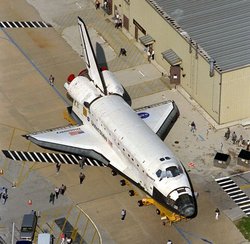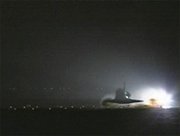|
|
|||||||||||||||||||||||||||||||||||||||||||||||||||||||||||||||||||||||||||||||||||||||||||||||||||||||||||||||||||||||||||||||||||||||||||||||||||
|
HOME | BIOLOGY | FILMS | GEOGRAPHY | HISTORY | INDEX | INVESTORS | MUSIC | SOLAR BOATS | SPORT |
|||||||||||||||||||||||||||||||||||||||||||||||||||||||||||||||||||||||||||||||||||||||||||||||||||||||||||||||||||||||||||||||||||||||||||||||||||
|
First flown on August 30, 1984, Discovery is the third operational space shuttle, and the oldest remaining in service. It has performed both research and International Space Station (ISS) assembly missions.
Rollout of the orbiter Discovery, 1998 (NASA)
The spacecraft takes its name from previous ships of exploration named Discovery, primarily HMS Discovery, a ship that accompanied explorer James Cook on his third and final major voyage. Others include Henry Hudson's ship Discovery which he used in 1610–1611 to search for a Northwest Passage, and RRS Discovery, a vessel used for expeditions to Antarctica in 1901-1904 by Scott and Shackleton (and still preserved as a museum). The shuttle shares a name with Discovery One, the spaceship from the film 2001: A Space Odyssey.
Discovery was the shuttle that launched the Hubble Space Telescope. The second and third Hubble Space Telescope service mission was also conducted by Discovery. It has also launched the Ulysses probe and three TDRS satellites. Discovery has been chosen twice as the return to flight orbiter, first as the return to flight orbiter after the Challenger Disaster in 1986, and as the orbiter for the return to flight mission in July 2005, after the Columbia Disaster. Discovery also carried Project Mercury astronaut John Glenn, who was 77 at the time, back into space during STS-95 on October 29, 1998, making him the oldest human being to venture into space.
Space Shuttle Discovery mission STS-114 lands safely on August 9, 2005
STS-114 mission
On July 26, 2005 at 10:39 EDT, Discovery launched into space on mission STS-114, marking the first shuttle launch since the February 2003 Columbia Disaster. Video taken during the minutes after the launch revealed that a piece of foam insulation came off Discovery's external fuel tank, although it apparently did not damage the shuttle. After the problem was discovered, NASA suspended all future launches until the problem is solved.
Discovery was set to return on August 8, 2005, but their mission was extended due to unfavorable weather conditions. The shuttle returned from orbit on August 9, 2005, landing at Edwards Air Force Base at 8:12 AM EDT after travelling 5.8 million miles.
Flights
Space Shuttle Discovery has flown 31 flights, spent 241.95 days in space, completed 3,808 orbits, and flown 98,710,673 miles (158,859,429 km) in total, as of July 2005. Discovery is set for retirement in 2010. Notable missions
List of space shuttle missions :
External links
Shuttle Orbiter Discovery (OV-103) Track Discovery with Google Maps Rockets
Alphabetical Spacecraft
- Families People
- Alphabetical Chronology Soviet
LK Lunar Lander R-56
Polyblock - SK-100 American LK-1
- LK-700 L3M-70
and L3M-72
AVIATION A - Z
A taste for adventure capitalists
Solar Cola - a healthier alternative
|
|||||||||||||||||||||||||||||||||||||||||||||||||||||||||||||||||||||||||||||||||||||||||||||||||||||||||||||||||||||||||||||||||||||||||||||||||||
|
This
website
is Copyright © 1999 & 2013 NJK. The bird |
|||||||||||||||||||||||||||||||||||||||||||||||||||||||||||||||||||||||||||||||||||||||||||||||||||||||||||||||||||||||||||||||||||||||||||||||||||
|
AUTOMOTIVE | BLUEBIRD | ELECTRIC CARS | ELECTRIC CYCLES | SOLAR CARS |
|||||||||||||||||||||||||||||||||||||||||||||||||||||||||||||||||||||||||||||||||||||||||||||||||||||||||||||||||||||||||||||||||||||||||||||||||||








